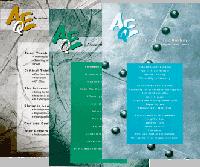Tools of the Online Trade for the Economically Challenged Educator

Academic Exchange Quarterly
The following article was published in the Academic Exchange Quarterly during my tenure with the journal as copy editor. Publication information is listed at the end of the essay.
I am thrifty, stingy, cheap, call it what you will. And it doesn't take long to spend money in online education. Computer (with constant upgrades), printer, ISP provider, software--the list is endless. Much of my experimentation with online education has been from my home computer on my personal budget. Like Tim the Toolman Taylor, I crave more computing power. My current home computer, purchased two years ago with a few upgrades since then, has a 686 Cyrix chip with 128 meg. of RAM, three hard drives (one 13 gig,. and two 3 gig.), a 20X CDROM drive, two 3.5 inch floppy drives, a 19 inch monitor, and a 56K modem. ArrrrArrrrArrrrr. I put the system together myself. I shop for the best buys and bought most of the equipment for this computer at a local computer show.
With software, my experience as a book club junkie (I am and have been a member of nearly a dozen book clubs over the years) has taught me how to sniff out a bargain. My addiction to freeware approaches the legendary with our campus information technology staff. Following are some of the resources I have found useful and would recommend.
ZDNet <http://www.zdnet.com/swlib/>, in my opinion, is the best site for shareware and freeware. All programs are virus-free. This site not only offers offers access to shareware and freeware but also provides a wealth of information and resources, including product reviews of hardware and software, JAVA and programming utilities, and information technology information. Three programs I was introduced to through ZDNet that I find indispensable are Arachnophilia <http://www.arachnoid.com/>, a full featured HTML/JAVA editor (I use it standalone and as the internal HTML editor in FrontPage 97); IrfanView <http://stud1.tuwien.ac.at/~e92274474/>, an image viewer/editor and multimedia player; and WS_FTP <http://www.ipswitch.com>, a file transfer client.
Creating a website requires access to graphics. I use PaintShop Pro 4 (I received a registered copy free with my XOOM modem, which tipped the scale in my modem purchase) for most of my graphics creation. Two sites I have found useful for creating web graphics, however, are webGFX <http://www.webgfx.ch/start.htm> and CoolText.com <http://www.cooltext.com/>. webGFX is an online graphics generator for creating a variety of website graphics from logos to navigation graphics. CoolText.com is a second online graphics generator for creating logos, buttons, and bullets. Both are worth a visit.
If you are looking to add full text search capabilities to your website, I have found FreeFind <http://www.freefind.com/> very attractive. Once you have established an account, FreeFind will index your site, allowing visitors to search every page using keywords or phrases. FreeFind is customizable and supported by banner advertising (the banners load quickly and are not intrusive).
One resource which I have not yet used is Response_O_Matic <http://www.response_o_matic.com/>. This site lets you create custom-designed forms for your website and handles the form processing, e-mailing the results to you.
In addition to these websites, I receive several e-newsletters that keep me abreast of news, websites, software, and technology concerns.
Edupage
Premium Links describes itself as "A Newsletter for the Discriminating Surfer." Distributed weekly, Premium Links features brief descriptions of web sites in five areas: Education, Business, The Arts, Home and Family, and Just for Fun along with a few short commentaries by the author. To subscribe to this free newsletter, visit the website at <http://premiumlinks.net> or send an e-mail message to <newsletter@premiumlinks.net> with "subscribe" (minus the quotes) in the body.
Lockergnome by Chris Pirillo of Des Moines, Iowa, is a daily e-newsletter that features software, websites, and computer tips for Windows 95/98/NT. To subscribe, visit <http://www.lockergnome.com/>.
Neat Net Tricks by Jack Teems is a bi-monthly e-newsletter providing software and website reviews and computer tips. To subscribe, visit <http://www.neatnettricks.com/> or send an e-mail to <majordomo@neatnettricks.com> and state in the text "subscribe neatnettricks" (all caps).
NetFuture, published by The Nature Institute, Ghent, New York, is an e-newsletter dealing with technology and human responsibility. Netfuture, which often discusses topics of interest to educators, is distributed every few weeks. Editor Steve Talbott is the author of The Future Does Not Compute: Transcending the Machines in Our Midst. To subscribe to Netfuture, send the message "subscribe netfuture yourfirstname yourlastname" to <listserv@maelstrom.stjohns.edu>. Current and past issues of Netfuture are available on the Web at <http://www.oreilly.com/~stevet/netfuture/>.
Bill Stifler
Copy Editor
Academic Exchange Quarterly 3.3 (1999): 4-5.